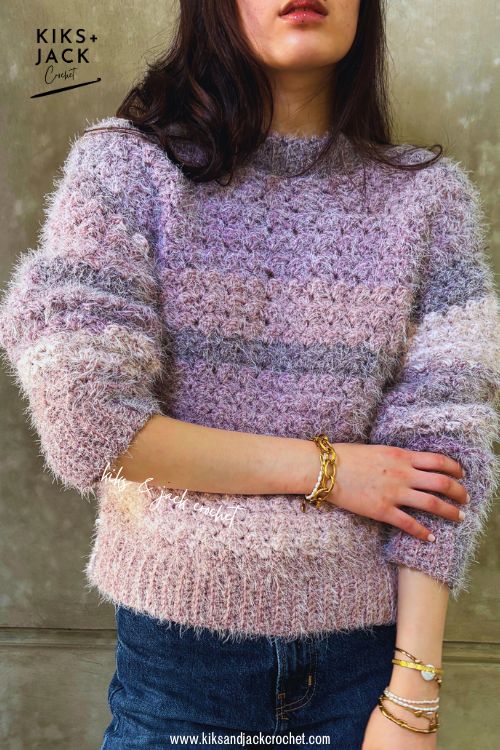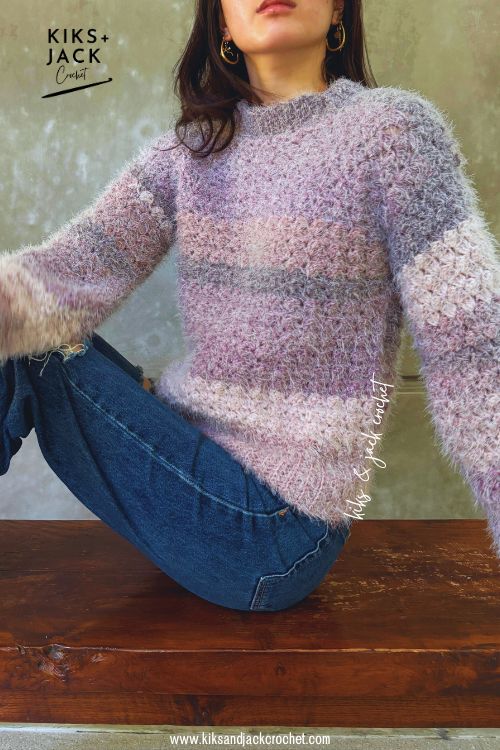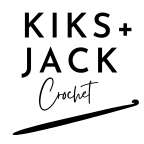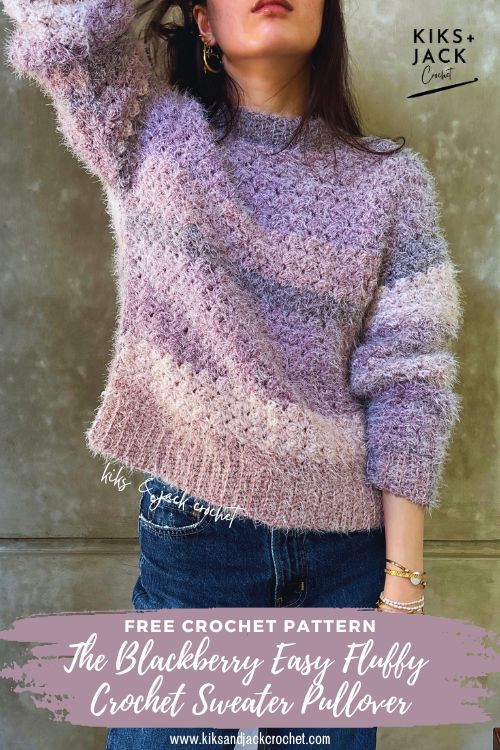The Blackberry Easy Fluffy Crochet Sweater Pullover is a free and easy crochet pattern, with “made to measure” instructions, size-inclusive, and designed to be intuitive and beginner-friendly. The step by step instructions below will help you create a soft, slightly fuzzy crew neck sweater with confidence. You can find the free pattern for The Blackberry Easy Fluffy Crochet Sweater Pullover posted below, and you can use the interactive table of contents just below this section to quickly navigate through the post and find exactly what you need.
For our version of The Blackberry Easy Fluffy Crochet Sweater Pullover, we used a larger hook size and a Bulky weight yarn and paired it with a stitch that works between clusters. It worked up SO fast, and this yarn was super smooth to crochet. We want to crochet 5 of these in every color. We decided to remove some of the black in this self striping yarn to soften the overall look. It’s always something to think about when you see a self striping yarn you love…but possibly don’t love ALL of it. The result is a slightly fuzzy, soft, and cozy texture that’s perfect for fall layers, with just enough visual interest from the subtle color changes.

“Yarn Curious” + “Pattern Refresh” 🌿
This is our second project in the “Yarn Curious” series. A little experiment that happens when we spot a yarn we can’t wait to crochet with and pair it with a pattern we already love. For the Blackberry Easy Fluffy Crochet Sweater Pullover, we were curious about how the self-striping Blackberry yarn would behave. Would it highlight the subtle color shifts? Would it feel cozy and light? How would it work up with a slightly larger hook and bulkier yarn? To check this out, we turned to a favorite of ours, The Field of Flowers Simple Beginner Crochet Sweater and adapted it to see how this specific yarn could shine. The original classic structure, paired with this soft, slightly fuzzy, yarn gave us something we are wearing ALL the time.
At the same time, we did a “Pattern Refresh.” With a larger hook, the sweater drapes a little more freely, yet the fluffiness prevents it from looking too “open”. The stitch from the main panels continues on the sleeves, and the neckline is finished more tightly for added warmth. We also changed up the ribbing to a single crochet ribbing. Together, these changes has given our Blackberry Easy Fluffy Crochet Sweater Pullover sweater a cozy, wearable feel while staying true to the original design.

We thought it would be helpful to have all the details in one place, so we are sharing this as a “Yarn Curious” + “Pattern Refresh” project. Check out our first project; The Cozy Fall Crochet Pullover Sweater.
Please support us by following us on social media. Simply click on the icons below and we will keep you up to date on new free pattern releases. Tag us your version of Blackberry Easy Fluffy Crochet Sweater Pullover so that we can add your work to our stories and share it with our followers too!
Please support us: We are trying to keep all our crochet patterns free for everyone, when you access them online. We meet the costs of running this website through coffee donations at https://ko-fi.com/kiksandjackcrochet and ad revenue. When you buy us a cup of coffee, you buy us a cup of motivation. Thank you for keeping us motivated and inspired every day to keep designing free crochet patterns for you.
DESCRIPTION of The Blackberry Easy Fluffy Crochet Sweater Pullover
The Blackberry Easy Fluffy Crochet Sweater Pullover is a soft, slightly fuzzy sweater that’s simple to make but full of texture. It can be customized to your preferred length shorter and cropped, or longer and relaxed using the made-to-measure instructions. The sleeves continue the main panel stitch, and the neckline is easy to adjust for a closer fit or a more open crew neck, giving you flexibility to make it your own.
This pattern is a free and easy crochet pattern, available as a size-inclusive, made-to-measure design. It’s beginner-friendly and works up quickly thanks to a stitch that mostly involves crocheting between clusters, paired with a larger hook. The slightly fluffy yarn helps maintain a cozy texture, and because it’s made to measure, the gauge is forgiving, allowing you to create a sweater that fits you perfectly.
CROCHET MEASUREMENTS & SIZES for The Blackberry Easy Fluffy Crochet Sweater Pullover
The pattern instructions are made to measure, based on your required measurements.
At Kiks + Jack Crochet, we aim to create patterns that are made-to-measure and size-inclusive rather than just graded sizes (XS – 5XL), so crocheters can enjoy the satisfaction of making a garment that fits perfectly. We also understand that taking measurements isn’t always convenient, so we’ve included standard measurements for anyone who prefers to follow them.
To use The Blackberry Easy Fluffy Crochet Sweater Pullover pattern you will need the following measurements and you should write them down for easy reference:
Chest/Bust: Measure around the fullest part of your chest/bust. Do not draw the tape too tightly.
Finished length: Measure from just below the waist (or where you would like the sweater to end) up to the top of your shoulder at your collarbone.
Armhole Depth: Measure from the top outside edge of the shoulder down to the armpit. You may want to check that this measurement – when doubled – is as big as your upper arm circumference (around your bicep). Typically it is, however every body shape is different. If your upper arm circumference is larger, take this measurement instead.
Arm Length: Measure from armpit to wrist (or where you would like the sleeve to end)
Wrist Circumference: Measure from one point on your wrist all around your wrist. Do not draw the tape too tightly.
Standard Measurements (For Reference)
If you would like to use standard sizing for the chest/bust – then for XS (S, M , L, XL, 2XL, 3XL, 4XL, 5XL) use approximately 28-30 (32-34, 36-38, 40-42, 44-46, 48-50, 52-54, 56-58, 60-62) inches or 71-76 (81-86, 91-96, 102-107, 112-117, 122-127, 132-137, 142-147, 152-158) centimetres.
If you would like to use standard sizing for armhole depth – then use approximately 6-6.5 (6.5-7, 7-7.5, 7.5-8, 8-8.5, 8.5-9, 9-9.5, 9.5-10, 10-10.5) inches or 15.5-16.5 (16.5-17.5, 17.5-19, 19-20.5, 20.5-21.5, 21.5-23, 23-24, 24-25.5, 25.5-26.5) centimetres
If you would like to use standard sizing for arm length – then for XS (S, M , L, XL, 2XL, 3XL, 4XL, 5XL) use approximately 16.5 (17, 17, 17.5, 17.5, 18, 18, 18.5, 18.5) inches or 42 (43, 43, 44.5, 44.5, 45.5, 45.5, 47, 47) centimetres
Note: The Blackberry Easy Fluffy Crochet Sweater Pullover is designed as an oversized fit with positive ease.
CROCHET GAUGE
The Blackberry Easy Fluffy Crochet Sweater Pullover is made to measure and can accommodate for different crochet gauges. You do not need to swatch and match to our gauge however we suggest for this pattern you use a yarn and hook of similar weight and size.
For our version of The Blackberry Easy Fluffy Crochet Sweater Pullover we used a weight 5 yarn and a 6mm hook.
CROCHET MATERIALS for The Blackberry Easy Fluffy Crochet Sweater Pullover
This section contains product affiliate links. We may receive a small commission (at no extra cost to you) if you make a purchase after clicking on one of these links.
Kiks + Jack Crochet promises to only recommend products that we love and that we use. Thank you for supporting us.
Yarn Brand: Caron Latte Cakes by Yarnspiration. Weight 5/Bulky 257g per skein and 530 yards (or 485 m). We used the colour Blackberry.
Kiks + Jack Crochet’s version of The Blackberry Easy Fluffy Crochet Sweater Pullover has a finished width of approximately 18 inches and a finished length of 20 inches. We used approximately 1.9 skeins in total, or 1010 yards (or 923 m).
Other yarns we would love to try out for The Blackberry Easy Fluffy Crochet Sweater Pullover include:
Caron Cloud Cakes by Yarnspiration
Scarfie by Lion Brand Yarns
Crochet Hook (we used a 6mm and a 5mm). We use many different crochet hooks and if you are looking for some great budget friendly ergonomic crochet hooks try these from Amazon. It comes in a set and the grip and the shape is amazing for beginner crocheters. We also love the slightly more pricey crochet hooks from Clover Crochet Hooks and the beautiful Furls Crochet Hooks (these are so stunning, we just love looking at them!)
Yarn Winder!!! (Our new LOVE). We had held off on a yarn winder for a long time. We love the idea of crochet being simple with just a hook and some yarn. However we decided to get this yarn winder, because it was affordable and we weren’t sure about investing in a super fancy one yet. We love it because it breathes life back into scrappy yarn lying around that looks messy. It’s simple to use and is holding up really well for us.
Measuring Tape. We use a super budget friendly measuring tape. Make sure it has cm and inches (not all patterns are written with both). We are always crocheting on the go so we like our tapes small and compact and we put one in our design area, one in our bag and one in our car. Retractable works best! We use these super cheap mini measuring tapes from Amazon
Stitch Markers. We use these locking crochet stitch markers from Amazon and these stitch markers that do not lock. They are cheap and colourful.
Blocking Pins. You should buy more pins than you think you need. If you are going to take the time to block don’t skimp on the pins. We like T shaped stainless steel pins that don’t rust when they get wet. We love these blocking T pins from Amazon and the tin means the pins don’t fall out on the floor.
Yarn Needle. Buy blunt needles with large eyes for yarn. We use these Yarn Needles because we like the convenient bottle, they are budget friendly and we get lots of them!
Scissors. We love these thread snippers because they are cheap, we get two of them AND they come with a case (some don’t). Don’t carry these without the case! After you use thread snippers you won’t want to snip with scissors.
CROCHET STITCHES & ABBREVIATIONS
The Blackberry Easy Fluffy Crochet Sweater Pullover pattern is written with US terms.
ch = chain (With one loop on your hook, yarn over and pull through the loop)
sc = single crochet (Insert hook into desired stitch. Yarn over and pull through the stitch. You now have two loops on your hook. Yarn over and pull through all two loops)
dc = double crochet (Yarn over and insert hook into desired stitch. Yarn over and pull through the stitch. You now have three loops on your hook. Yarn over and pull through the first two loops. You now have two loops on your hook. Yarn over and pull through all two loops)
sl st = slip stitch (Insert hook into desired stitch. Yarn over and pull through the stitch and the loop on your hook)
BLO = back loop only
tch = turning chain
st = stitch
sk = skip stitch
* = repeat the instructions following the * as directed
Note unless stated otherwise turning chains do not count as a stitch if there are 1 or 2 chains and the turning chain does count as a stitch if there are 3 or 4 chains.
SUMMARY of CONSTRUCTION for The Blackberry Easy Fluffy Crochet Sweater Pullover
The Blackberry Easy Fluffy Crochet Sweater Pullover is worked by first creating a back panel and a matching front panel. You’ll begin by crocheting the ribbing at the bottom, then continue working the panels from the bottom up. Once the panels are complete, you’ll create the neckline opening on both the front and back panels.
Next, you’ll crochet the sleeve ribbing followed by the sleeve panels. Finally, the shoulders are joined by seaming the front and back panels together, and the sleeves are attached directly to the body. The sweater is finished with the ribbed neckline, giving it a cozy, comfortable fit that frames the crew neck beautifully.
PERMISSIONS AND COPYRIGHT
You may not publish or share any pattern on this website www.kiksandjackcrochet as your own including this pattern The Blackberry Easy Fluffy Crochet Sweater Pullover. Except as permitted by the copyright law applicable to you, you may not reproduce or communicate any of the content on this website, including files downloadable from this website, without the permission of the copyright owner, Kiks + Jack Crochet.
You may not use any Kiks and Jack Crochet photo as your own photo.
You may crochet items to sell using The Blackberry Easy Fluffy Crochet Sweater Pullover pattern upon permission by email at [email protected]. Please link back to this post in exchange.
Crochet Pattern Instructions for The Blackberry Easy Fluffy Crochet Sweater Pullover
Just a note about our color striping: we used a self striping yarn and generally went wherever the yarn wanted to go ie. our stripes do not necessarily match on each side as we love the random stripe look. However we did reduce the black yarn and generally limited it to two rows only.
Crochet the Back Panel Ribbing
ch 12
The height of our ribbing is approximately 3 inches. Based on our gauge this is approximately 12 chains. You can adjust the number of chains if you want to change the height of the ribbing or you are using a yarn with a different gauge.
Row 1: sc in 2nd ch from hook, sc in each ch across until end. Turn
Row 2: ch1, sc BLO in each st across, however on the last st sc into the entire stitch. Turn
Repeat row 2 until the total length of the ribbing is equal to HALF of your “Chest/Bust Measurement” plus 2 inches.
K+J example: Our chest/bust measurement = 32 inches around. Half of 32 inches = 16 inches. We keep repeating row 2 until the total length of the ribbing reaches 18 inches (16 +2 = 18 inches)
Count the total number of rows.
K+J example: We counted a total of 54 single crochet rows to achieve a length of approximately 18 inches.
It’s a great time to check if you are completely happy with the width of the sweater before you crochet any further. Place the ribbing up against you to see if the width (length of ribbing) is right for you. If you would like it to be wider and more loose, crochet a few more rows. If you would like the ribbing to be narrower and tighter, then you can frog (unravel) a few rows. Note that the width of the main body will increase a little more depending on your gauge.
Do not fasten off.
Crochet the Back Panel
You will now crochet down the long side of the ribbing that you just crocheted.
To calculate the number of stitches that you will crochet down the long side of the ribbing, calculate as follows:
| Calculation | Kiks+Jack Crochet Example |
| Count the number of rows in your ribbing | We have 54 rows in our ribbing |
| If this number is NOT a multiple of 3 then increase it until it is a multiple of 3 (divides into 3 evenly). If this number is already a multiple of 3, then leave it as is. | 54 is a multiple of 3 so we keep it as is. |
| Add one more chain | 54 + 1 = 55 stitches |
Row 1: Using the working yarn, ch1, sc into the first st, sc across the ribbing the number of stitches you calculated above in total. Turn
In K+J example above we will crochet 55 single crochets across the long side ribbing.
Tip: You may want to place some stitch markers across the ribbing at the 1/4, 1/2 and 3/4 marks. Then divide the number of stitches you need to crochet by 4 to give you an approximate idea of how many stitches you need to crochet in each quarter so you can ensure you are crocheting evenly.
Row 2: ch1, sc into 1st st, sc across into each st until end. Turn
Row 3: ch2 (counts as a st), 2dc in 1st st, sk next 2 st, *[1sc, 2dc] in next st, sk next 2 st, rep from * towards the end of row with 1sc in last st. Turn
The next row should look a little like placing [1sc, 2dc] between the clusters from the previous row.
Row 4: ch1 (counts as a st), 2dc in 1st st, sk 2st *[1sc, 2dc] in next st, sk next 2 st, rep from * towards the end of row with 1sc in top of tch. Turn
Repeat row 4 until the total length of your panel including the ribbing is equal to your “Finished Length Measurement” minus 2 inches.
Fasten off.
Crochet the Front Panel
Repeat all the instructions under Back Panel Ribbing and Back Panel. However repeat row 4 until the total length including the ribbing is equal to your “Finished Length Measurement” minus 3 inches. If you want a deeper or lower neckline at the front, then instead of 3 inches, you can increase it to 4+ inches).
Measure the Neckline on the Back and and Front Panel
Next, we will work on the neckline for the back and front panels. We prefer to crochet the panels first without the neckline so you can “try it on” and decide the perfect width for your neck opening before working the final stitches.
Start by measuring about 5 inches in from the left edge of the back panel and place a locking stitch marker (you’ll adjust this distance as needed). Repeat on the right side of the back panel. Then, measure the same distance on the front panel and mark both sides.
Line up the front and back panels using the four stitch markers and lock them together with the locking stitch markers. Place the panels over your head to check the fit of the neck opening. If you prefer a snugger neckline, move the markers closer together; for a wider opening, move them farther apart. Remember you will be adding a crochet ribbing around the neckline – approximately 1.5 inches, although it is customizable.
Be sure your final stitch markers sit between clusters, not in the middle of a cluster. Make sure the distance is the same on both sides and on the front and back panels, using a measuring tape for accuracy.
For Kiks + Jack’s version, we crocheted a total width of approximately 18 inches and measured approximately 6 inches from each side.
Crochet the Neckline on the Back and Front Panel
Crochet the Neckline on the Left Side Back Panel
Once you are satisfied with the neckline measurements, we will start to crochet it. Start with the back panel and attach the yarn to the first stitch near the left shoulder.
Row 1: ch1 (counts as a st), 2dc in 1st st, sk 2st, *[1sc, 2dc] in next st, sk next 2 st, rep from * towards the stitch marker, ending with 1sc in the stitch with the stitch marker. Turn
Row 2: ch1 (counts as a st), 2dc in 1st st, sk 2st, *[1sc, 2dc] in next st, sk next 2 st, rep from * towards the end with 1sc in the tch. Turn
Repeat row 2 until the total back panel (ribbing + main back panel + neckline) is equal to your “Finished Length Measurement“. We like to place it up against us an additional check that everything looks good.
Fasten off.
Crochet the Neckline on the Right Side Back Panel
You will now crochet on the right side of the back panel. Attach a yarn at the second stitch marker that is marking out the neckline.
Row 1: ch1 (counts as a st), 2dc in 1st st, sk 2st *[1sc, 2dc] in next st, sk next 2 st, rep from * away from the stitch marker and towards the end of the row, ending with 1sc in top of tch. Turn
Row 2: ch1 (counts as a st), 2dc in 1st st, sk 2st *[1sc, 2dc] in next st, sk next 2 st, rep from * towards the centre, ending with 1sc in the tch. Turn
Repeat row 2 until the total back panel (ribbing + main back panel + neckline) is equal to your “Finished Length Measurement“. ie. the neckline should be the same length as the left side of the back panel.
Crochet the Neckline on the Right Side and Left Side Front Panel
Repeat the instructions for the front panel, for both the left side and right side. You should have a slightly deeper neckline for the front panel compared to the back panel, unless you customized this differently.
Fasten off.
Crochet the Sleeve Panel (Make 2)
We will now crochet the two sleeve panels starting with the cuff. Remember you will need to make two identical sleeve panels.
Crochet the Sleeve Panel Ribbed Cuff
ch 12
Row 1: sc in 2nd ch from hook, sc in each ch across until end. Turn
Row 2: ch1, sc BLO in each st across, on the last st sc into the entire stitch. Turn
Repeat row 2 until the ribbed cuff is equal to your “Wrist Circumference Measurement” + 2 inches. Make sure it fits comfortably and is not too tight.
Count the number of rows (we crocheted 32 rows).
Do not fasten off. Turn your ribbing. You will now crochet down the long side of the ribbing.
Crochet the Main Sleeve Panel
To calculate the number of stitches across the ribbing, calculate as follows:
| Calculation | K+J Example |
| Count the number of rows in the sleeve cuff | We counted 32 rows in our cuff |
| If this number is NOT a multiple of 3 then increase it until it is a multiple of 3 (divides into 3 evenly). If this number is already a multiple of 3, then leave it as is. Add one more chain | 32 is not a multiple of 3 so we round this to 33. We add one more chain to total 34. |
Row 1: ch1, sc across the ribbing the total stitches calculated in the table above. Turn.
In K+J example, we would crochet 34 sc across the ribbing.
Row 2: ch1, sc into 1st st, sc across into each st until end. Turn
Row 3: ch2 (counts as a st), 2dc in 1st st, sk next 2 st, *[1sc, 2dc] in next st, sk next 2 st, rep from * towards the end of row with 1sc in last st. Turn
Row 4: ch1 (counts as a st), 2dc in 1st st, sk 2st *[1sc, 2dc] in next st, sk next 2 st, rep from * towards the end of row with 1sc in top of tch. Turn
Measure the width of your sleeve panel. You need this width to be [2 x your Armhole Depth Measurement + 1.5 inches]. For example our armhole depth measurement is approximately 6.5 inches. So we need the width of our sleeve panel to be approximately 14.5 inches wide.
We will now use expanding rows until the sleeve panel is wide enough based on your dimensions.
Row A: ch3 and place a SM in the 1st chain from the hook. Crochet 3dc into the 2nd ch from the hook. Crochet [1sc,2dc] into the 1st stitch of the original row, sk next 2 st, *[1sc, 2dc] in next st, sk next 2 st, rep from * towards the end of row with [1sc,2dc] in last st. Turn
Your row may look a little wonky, but it will give you 2 extra clusters to expand the row and after blocking the sleeve (you must block) it will soften the increase and straighten out.
Row B: ch1 (counts as a st), 2dc in 1st st, sk 2st *[1sc, 2dc] in next st, sk next 2 st, rep from * towards the end of row with 1sc in last st (use the SM from previous row to guide you). Turn
Row C: repeat Row B
Repeat Rows A – C in that order until your sleeve width has expanded to your required width.
When your sleeve has reach the desired width then repeat Row B and do not expand any further (i.e stop Row A). Continue Row B until the length of the sleeve panel reaches your “Arm Length Measurement”.
Fasten off.
Remember to crochet two identical sleeve panels.
Assembling The Blackberry Easy Fluffy Crochet Sweater Pullover
Kiks + Jack Crochet highly recommends blocking all your panels before assembly. Blocking your panels will set your panels to the shape and size you want and give it a polished look.
It is important you block your sleeve panels for this design. Place blocking pins specifically in the areas of increase.
We block our panels by pinning all the pieces on to an old yoga mat and manipulating the shape and edges so the front and back panel are similar and the two sleeve panels are similar. We then spray it with water focusing on the edges and ensuring it is well saturated. Do not remove the pins until the panels are completely bone dry.
Step 1: Seam the Front and Back Panel at the shoulder.
Place the front and back panels together with the right sides facing together. With a yarn needle, seam the two panels together across the shoulders starting from the edge and across. Fasten off.
Step 2: Line up your sleeves at the midway point to the shoulder and seam.
Lay your joined front and back panels flat with the right side facing down and the wrong side facing up. Take one sleeve and fold it in half lengthwise to find the midpoint, marking it with a stitch marker. With the wrong side of the sleeve facing upward, line up the marked center point with the outer edge of the left shoulder seam and secure it in place using the stitch marker.
This is the perfect time to double-check your sleeve length before seaming. Use a few locking stitch markers to temporarily attach the sleeve to the main panel, then try the sweater on. If you prefer longer sleeves (for example, cuffs that reach closer to the knuckles), simply undo the fastening knot on your sleeve and add a few extra rows. If you’d rather have shorter sleeves, remove the fastening knot and frog a few rows until you reach your desired length. Be sure to adjust both sleeves evenly so they match in length.
Once you’re happy with the fit, use a yarn needle and matching yarn to seam the sleeves to the body panels with the wrong side facing up (see the first diagram below for reference). Repeat the same process for the opposite sleeve.
Step 3: Seam the sides of the sweater and the bottom of the sleeve together.
Fold your sweater at the shoulder seams so that it’s wrong side out. Using a yarn needle and matching yarn, carefully seam the sides of the front and back panels together up to the underarm, then continue seaming along the underside of the sleeve until closed.
Fasten off.
Step 4: Add the ribbing to the neckline
We will be working on a stitch video for this neckline ribbing to complement the written instructions. When it is ready we will embed the video here.
Turn the sweater right side out. Attach a yarn to the side of the neckline.
We dropped down a hook size for a tighter ribbing (to a 5mm). This is optional.
Foundation Row: ch1, sc in the first st, sc evenly around the neckline – try to keep the distance even and approximately one stitch length based on your guage. When you complete the round, sl st to join at the top of the tch.
We will now start crocheting the ribbing around the foundation row.
Row 1: ch 6. Turn
Tip: A chain 6 gave us a ribbing height based on our gauge of about 1.5 inches. You can adjust this if (based on your gauge) you would like this shorter or higher.
Row 2 (working back along the chain): sc in 2nd ch from hook and in each ch across (total 5 sc), at the base, sl st in next sc, then sl st again in next sc (ie. you skip the stitch directly below the ch 6). Turn
Row 3 (you are working back up ribbing and start by bringing the working yarn to the left of the hook and towards the back): sc in BLO of first 4 stitches, sc through both loops of last st. Turn.
Row 4: ch1, sc in BLO of each st across (5 sc), at the base sl st in next sc, sl st in next sc. Turn.
Repeat rows 3-4 all around the neckline. When you finish the last row (when the two ends meet), fasten off with a long tail and seam to the first row with a yarn needle.
Fasten off.
Finish & Celebrate The Blackberry Easy Fluffy Crochet Sweater Pullover
Weave in all your ends.
Congratulations you have finished The Blackberry Easy Fluffy Crochet Sweater Pullover and we hope you enjoyed this free crochet pattern.
We love and live off coffee. If you would like to buy us a coffee you can at: https://ko-fi.com/kiksandjackcrochet or click on the icon. Thank you for helping us build this blog.
It would be amazing to see a photo of your completed work on instagram. Tag us @kiksandjackcrochet.
Follow us on social media for new pattern releases and work in progress.



